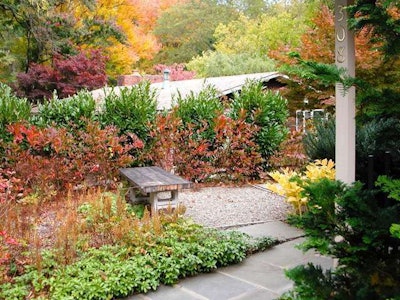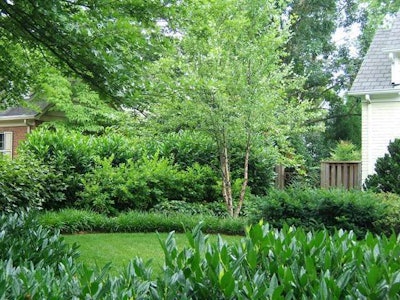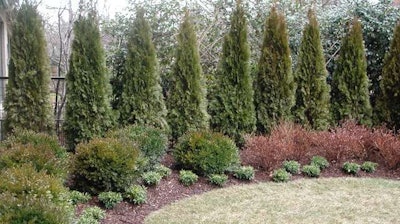
 This client has skip laurels fronted by Virginia sweetspire blocking out the neighbor’s view.
This client has skip laurels fronted by Virginia sweetspire blocking out the neighbor’s view.Photo: GreenHeart Garden Design
After your company has created a backyard oasis for a client, don’t be surprised if the customer notices something missing – not from your landscape design, which no doubt is flawless, but rather all along the periphery of it.
Before you created the green sanctuary that now beckons them, your clients may never have noticed how little privacy their backyard offered.
Instead of giving them the number of a reputable fence company, why not discuss ways of solving the problem yourself? A living privacy screen could be just what they need.
Here’s a few questions to consider before embarking on the creation of a natural privacy fence:
Is the the space urban or suburban?
If your client is in an urban area, space is the immediate issue. However, this doesn’t mean the situation is hopeless.
“It’s a little bit more of a challenge,” says Jan-Gerrit Bouwman, senior landscape architect for Grant & Power Landscaping in West Chicago. “You have to be more creative and see what the options are.”
One option is using a vertical garden to shield your customer’s property from prying eyes. For homes that are surrounded by taller buildings, an arched trellis with climbing vines can serve as a solution.
According to Bouwman, it can take as long as two years for a trellised privacy screen to be effective, but sometimes a screen’s effect can be instantaneous depending on what trees the clients choose.
Another possible screening strategy for urban areas is to use raised planters with thick ornamental grasses, such as feather reed grass, which softens the barrier between your client and the outside world.
Formal or informal?
Obviously, for customers who do have more space, the design possibilities are much broader. Depending on the style of the house, current landscaping and the owner’s desires, living privacy screens can be as formal or as informal as the client prefers.
 A more informal privacy screen contains skip laurels fronted by Virginia sweetspire and two other layers of perennials in the foreground, plus a river birch.
A more informal privacy screen contains skip laurels fronted by Virginia sweetspire and two other layers of perennials in the foreground, plus a river birch.Photo: GreenHeart Garden Design
“A natural look can consist of a mix of plants arranged in a staggered fashion,” says Debbie Friedman, principal and designer for Bethesda Garden Design in Bethesda, Maryland. “A formal look can be one plant in a row or hedged.”
Older, regal-looking houses may be more suited for a formal trimmed hedge. Privet and boxwood are common shrub choices for the traditional privacy barrier.
When going for a natural look, layered plantings create a vibrant texture. Mix a selection of trees, shrubs, perennials and annuals so that there is a healthy variety. Staggered planting of shrubs, perennials and trees make the barrier seem less harsh, but still creates the seclusion your client wants.
Evergreen or sometimes green?
When it comes down to the actual selection of the plants, determine whether your client is concerned with privacy year-round or if they don’t mind the backyard being visible in the winter.
Evergreens are the popular choice due to their fast growth and constant foliage. Friedman advises using evergreens such as skip laurels or Hicks yew for midsize barriers and Green Giant Arborvitae for taller screens.
 These are a smaller Thuja species than Green Giant Arborvitae, but they can still create a definite barrier.
These are a smaller Thuja species than Green Giant Arborvitae, but they can still create a definite barrier.Photo: GreenHeart Garden Design
Deciduous trees have their perks as well, with pretty blossoms in the spring and bursts of fiery colors in the fall. Small trees such as Japanese maple and flowering dogwoods can help spread out the base of a mixed screen.
“If a new McMansion is being built next door, I often recommend planting a combination of pointy-topped evergreens and wide-headed deciduous trees,” says Cathy Carr, principal of GreenHeart Garden Designs in Silver Spring, Maryland.
Carr also suggests Green Giant Arborvitae, along with Cryptomeria japonica and Nellie R. Stevens Holly, as good evergreen choices for the Zone 7 climate in which she works.
“River birch is good for damp sites and sugar maples have terrific fall foliage color,” Carr says. “Both are fast-growing.”
Plan ahead
The final thing to consider when selecting plants for the living screen is the future size of the plant. Don’t plant shrubs and trees closely together just to get some instant privacy. Keep their mature sizes in mind and give them the proper space to grow, otherwise they will crowd each other and won’t get the sunlight they need.
“You don’t want to plant a 60-foot-tall shade tree when you only need to block the neighbor’s upstairs window that’s 20 feet high,” Carr says. “Installing larger trees requires a major commitment to watering, so maintenance is always important.”
Of course, shade and soil conditions are other factors to consider. For a list of some more possible plants to use for privacy screens, click here.










